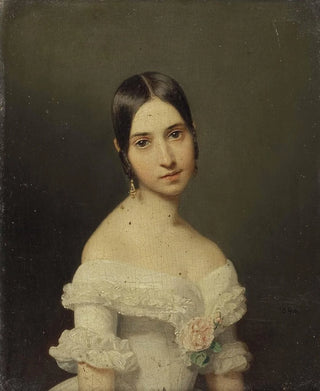Art print | Portrait of a girl - Ferdinand Georg Waldmüller


View from behind

Frame (optional)
Portrait of a Girl - Ferdinand Georg Waldmüller – Captivating Introduction
The "Portrait of a Girl" by Ferdinand Georg Waldmüller is a work that immediately captivates with its charm and delicacy. Painted in the 19th century, this canvas evokes an era when art was intimately intertwined with daily life, where every detail was carefully thought out to convey emotion. The depiction of a young girl, both innocent and full of life, immerses us in a universe where beauty and simplicity coexist harmoniously. The child's gaze, both curious and dreamy, invites us to share a suspended moment in time, reminding us of the evocative power of art.
Style and uniqueness of the work
The uniqueness of this art print lies in Waldmüller's technical mastery, who manages to capture not only the physical features of his model but also the very essence of her being. The colors, delicate and nuanced, play a vital role in creating an intimate atmosphere, while the light seems to caress the young girl's face, accentuating her gentle and contemplative expression. Every brushstroke demonstrates a meticulous attention to detail characteristic of this artist's work, revealing a particular sensitivity to human emotions. The background, simple and discreet, highlights the main subject, allowing the viewer to focus fully on the luminous face of the child. This work, through its apparent simplicity, invites deep contemplation, where each gaze can discover a new facet of her beauty.
The artist and his influence
Ferdinand Georg Waldmüller, an emblematic figure of Austrian Romanticism, knew how to mark his era with an innovative approach to portrait painting. Born in 1793, he was influenced by the aesthetic ideas of his time while developing a personal style that was uniquely his own. Waldmüller stands out for his ability to combine realism and idealization, creating works that speak to the sensitivity of his audience. His interest in daily life and children's portraits reflects a desire to represent beauty in its purest form. The impact of his work is still felt today, inspiring many contemporary artists who seek to capture the human soul through their art.

Matte finish

View from behind

Frame (optional)
Portrait of a Girl - Ferdinand Georg Waldmüller – Captivating Introduction
The "Portrait of a Girl" by Ferdinand Georg Waldmüller is a work that immediately captivates with its charm and delicacy. Painted in the 19th century, this canvas evokes an era when art was intimately intertwined with daily life, where every detail was carefully thought out to convey emotion. The depiction of a young girl, both innocent and full of life, immerses us in a universe where beauty and simplicity coexist harmoniously. The child's gaze, both curious and dreamy, invites us to share a suspended moment in time, reminding us of the evocative power of art.
Style and uniqueness of the work
The uniqueness of this art print lies in Waldmüller's technical mastery, who manages to capture not only the physical features of his model but also the very essence of her being. The colors, delicate and nuanced, play a vital role in creating an intimate atmosphere, while the light seems to caress the young girl's face, accentuating her gentle and contemplative expression. Every brushstroke demonstrates a meticulous attention to detail characteristic of this artist's work, revealing a particular sensitivity to human emotions. The background, simple and discreet, highlights the main subject, allowing the viewer to focus fully on the luminous face of the child. This work, through its apparent simplicity, invites deep contemplation, where each gaze can discover a new facet of her beauty.
The artist and his influence
Ferdinand Georg Waldmüller, an emblematic figure of Austrian Romanticism, knew how to mark his era with an innovative approach to portrait painting. Born in 1793, he was influenced by the aesthetic ideas of his time while developing a personal style that was uniquely his own. Waldmüller stands out for his ability to combine realism and idealization, creating works that speak to the sensitivity of his audience. His interest in daily life and children's portraits reflects a desire to represent beauty in its purest form. The impact of his work is still felt today, inspiring many contemporary artists who seek to capture the human soul through their art.






